Abstract
The effect of idoxifene, a novel anti-oestrogen with less agonist activity than tamoxifen, was compared with that of tamoxifen on the growth of hormone-dependent MCF-7 breast cancer xenografts. Forty tumours were established with oestradiol support in ovariectomized athymic mice, allowed to grow to a median volume of 420 mm3 and then continued with oestradiol, no support, tamoxifen or idoxifene delivered by 1.5-cm silastic capsule. Tumour regression occurred with both anti-oestrogens, although maximum regression was observed following oestradiol withdrawal alone. While prolonged anti-oestrogen therapy was associated with static growth, tumour volumes were significantly lower with idoxifene (P=0.01). After 6 months, 0/10 idoxifene-treated tumours developed acquired resistance compared with 3/10 tumours treated with tamoxifen. In separate experiments, 94 animals were treated initially with oestradiol, tamoxifen, idoxifene or placebo following implantation with 1-mm3 pieces of either wild-type (WT) or tamoxifen-resistant (TR) MCF-7 tumour. After 4 months, only 1/11 WT tumours became established with idoxifene compared with 4/11 with tamoxifen, 8/12 with oestradiol and 0/12 with placebo. Likewise, fewer TR tumours were supported by idoxifene (3/12) than by tamoxifen (8/12) or oestrogen (11/12). These data indicate that, compared with tamoxifen, idoxifene shows reduced growth support of MCF-7 xenografts and may share only partial cross-resistance. Furthermore, the development of acquired anti-oestrogen resistance may be reduced during long-term idoxifene therapy. The drug's reduced agonist activity may, in part, explain these observations and indicate a preferable biochemical profile for breast cancer treatment.
Full text
PDF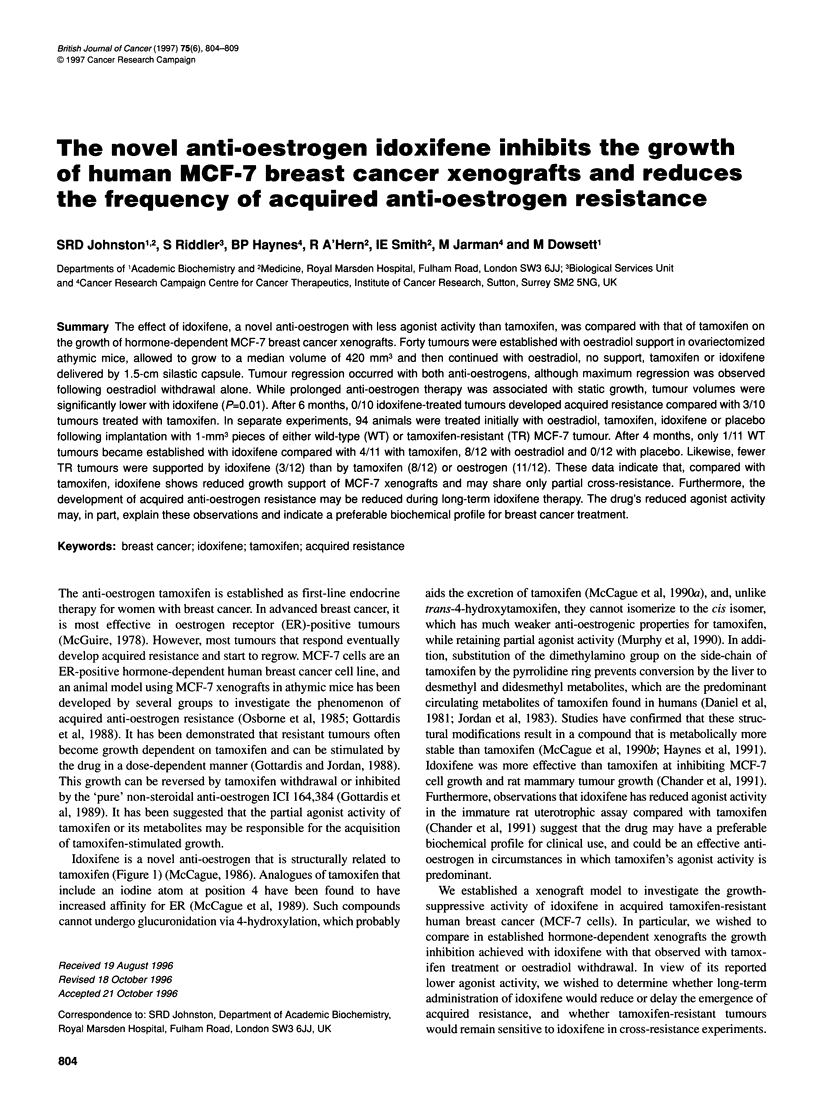
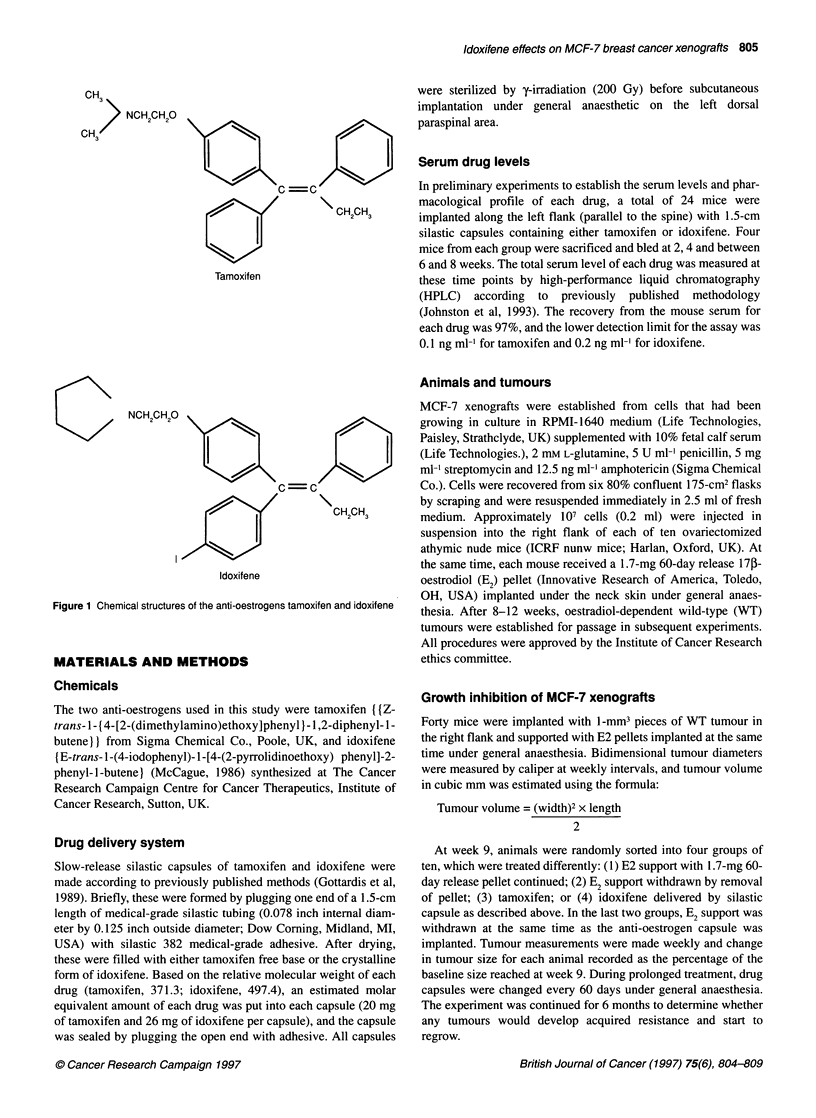
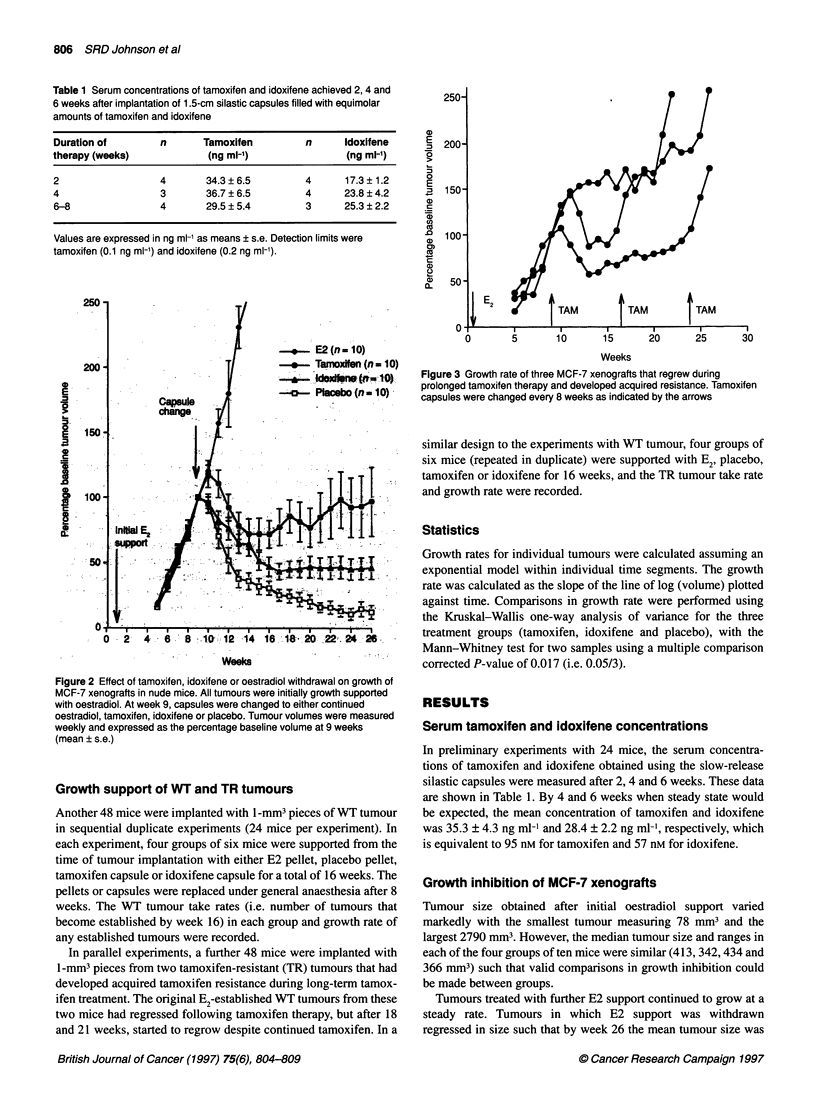
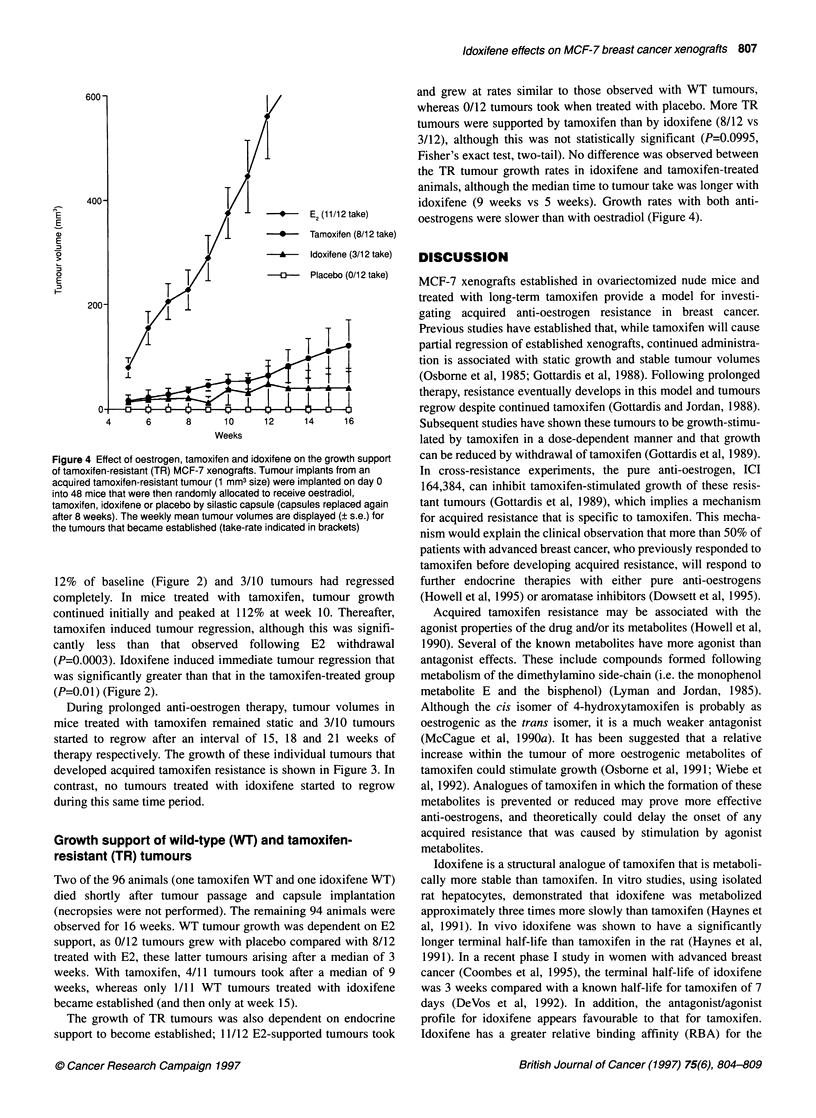
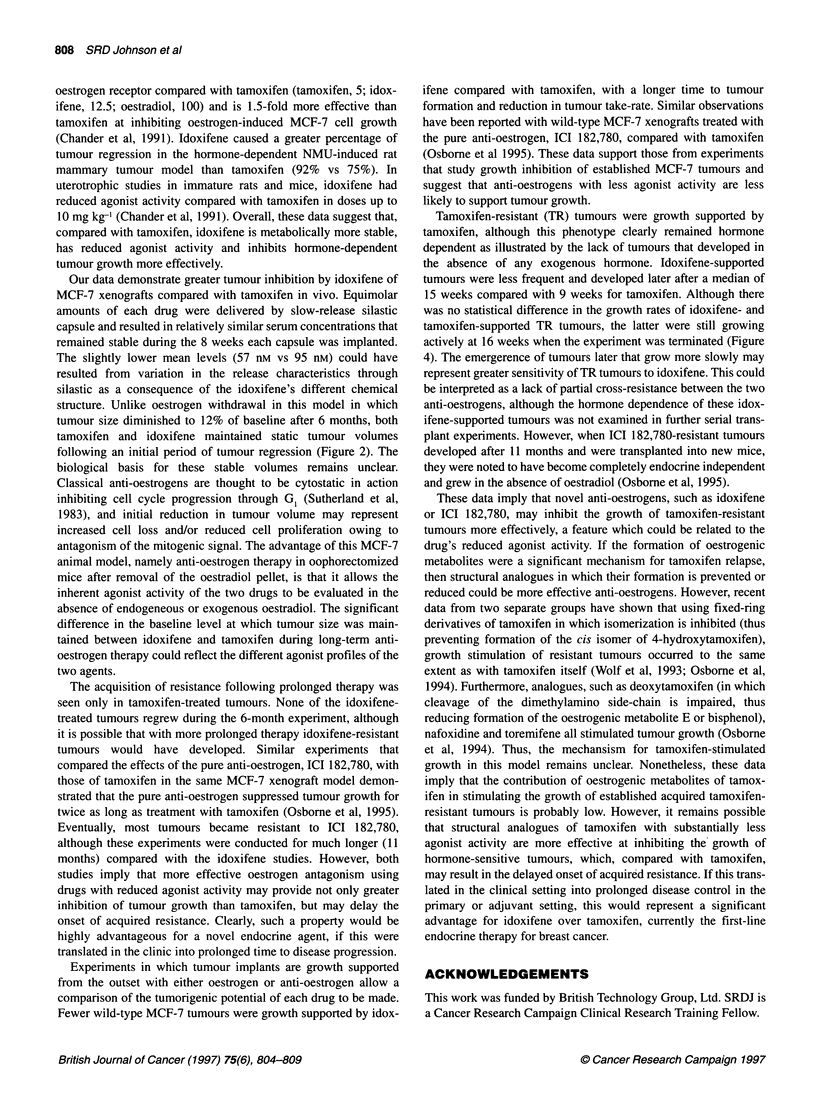
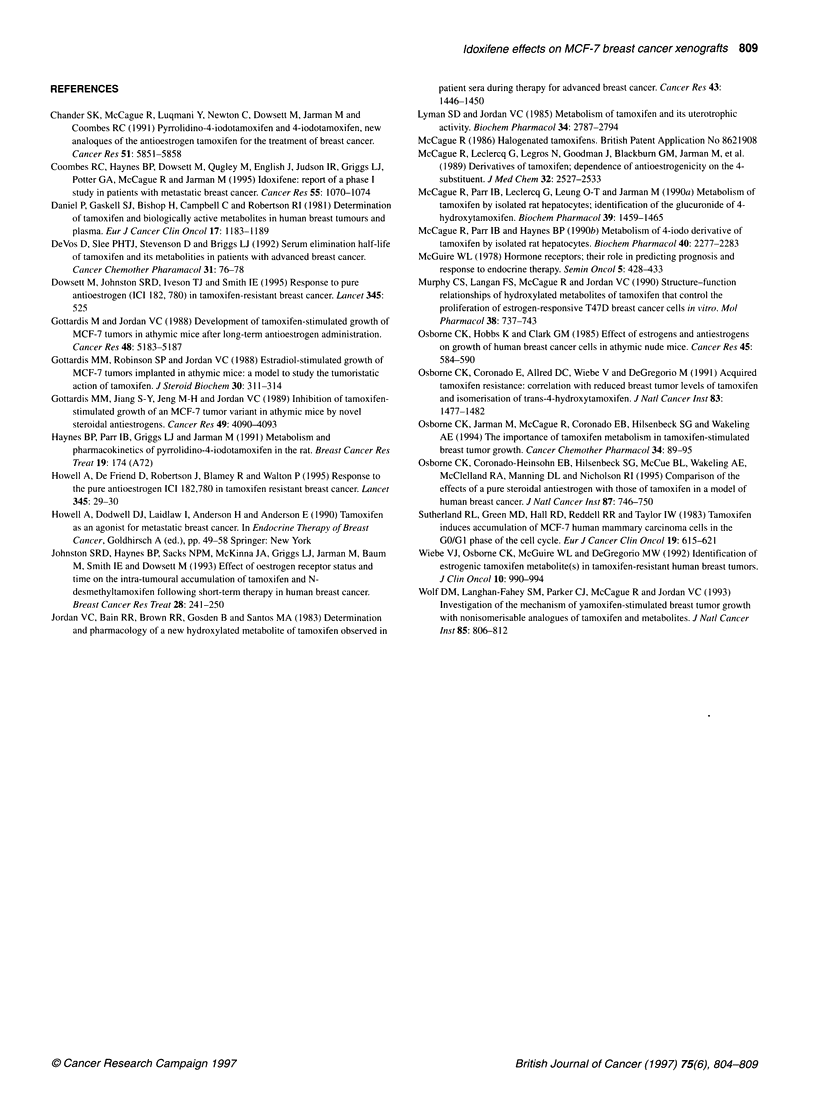
Selected References
These references are in PubMed. This may not be the complete list of references from this article.
- Chander S. K., McCague R., Luqmani Y., Newton C., Dowsett M., Jarman M., Coombes R. C. Pyrrolidino-4-iodotamoxifen and 4-iodotamoxifen, new analogues of the antiestrogen tamoxifen for the treatment of breast cancer. Cancer Res. 1991 Nov 1;51(21):5851–5858. [PubMed] [Google Scholar]
- Coombes R. C., Haynes B. P., Dowsett M., Quigley M., English J., Judson I. R., Griggs L. J., Potter G. A., McCague R., Jarman M. Idoxifene: report of a phase I study in patients with metastatic breast cancer. Cancer Res. 1995 Mar 1;55(5):1070–1074. [PubMed] [Google Scholar]
- Daniel P., Gaskell S. J., Bishop H., Campbell C., Nicholson R. I. Determination of tamoxifen and biologically active metabolites in human breast tumours and plasma. Eur J Cancer Clin Oncol. 1981 Nov;17(11):1183–1189. [PubMed] [Google Scholar]
- Dowsett M., Johnston S. R., Iveson T. J., Smith I. E. Response to specific anti-oestrogen (ICI182780) in tamoxifen-resistant breast cancer. Lancet. 1995 Feb 25;345(8948):525–525. doi: 10.1016/s0140-6736(95)90624-x. [DOI] [PubMed] [Google Scholar]
- Gottardis M. M., Jiang S. Y., Jeng M. H., Jordan V. C. Inhibition of tamoxifen-stimulated growth of an MCF-7 tumor variant in athymic mice by novel steroidal antiestrogens. Cancer Res. 1989 Aug 1;49(15):4090–4093. [PubMed] [Google Scholar]
- Gottardis M. M., Jordan V. C. Development of tamoxifen-stimulated growth of MCF-7 tumors in athymic mice after long-term antiestrogen administration. Cancer Res. 1988 Sep 15;48(18):5183–5187. [PubMed] [Google Scholar]
- Gottardis M. M., Robinson S. P., Jordan V. C. Estradiol-stimulated growth of MCF-7 tumors implanted in athymic mice: a model to study the tumoristatic action of tamoxifen. J Steroid Biochem. 1988;30(1-6):311–314. doi: 10.1016/0022-4731(88)90113-6. [DOI] [PubMed] [Google Scholar]
- Howell A., DeFriend D., Robertson J., Blamey R., Walton P. Response to a specific antioestrogen (ICI 182780) in tamoxifen-resistant breast cancer. Lancet. 1995 Jan 7;345(8941):29–30. doi: 10.1016/s0140-6736(95)91156-1. [DOI] [PubMed] [Google Scholar]
- Johnston S. R., Haynes B. P., Sacks N. P., McKinna J. A., Griggs L. J., Jarman M., Baum M., Smith I. E., Dowsett M. Effect of oestrogen receptor status and time on the intra-tumoural accumulation of tamoxifen and N-desmethyltamoxifen following short-term therapy in human primary breast cancer. Breast Cancer Res Treat. 1993 Dec;28(3):241–250. doi: 10.1007/BF00666585. [DOI] [PubMed] [Google Scholar]
- Jordan V. C., Bain R. R., Brown R. R., Gosden B., Santos M. A. Determination and pharmacology of a new hydroxylated metabolite of tamoxifen observed in patient sera during therapy for advanced breast cancer. Cancer Res. 1983 Mar;43(3):1446–1450. [PubMed] [Google Scholar]
- Lyman S. D., Jordan V. C. Metabolism of tamoxifen and its uterotrophic activity. Biochem Pharmacol. 1985 Aug 1;34(15):2787–2794. doi: 10.1016/0006-2952(85)90580-5. [DOI] [PubMed] [Google Scholar]
- McCague R., Leclercq G., Legros N., Goodman J., Blackburn G. M., Jarman M., Foster A. B. Derivatives of tamoxifen. Dependence of antiestrogenicity on the 4-substituent. J Med Chem. 1989 Dec;32(12):2527–2533. doi: 10.1021/jm00132a006. [DOI] [PubMed] [Google Scholar]
- McCague R., Parr I. B., Haynes B. P. Metabolism of the 4-iodo derivative of tamoxifen by isolated rat hepatocytes. Demonstration that the iodine atom reduces metabolic conversion and identification of four metabolites. Biochem Pharmacol. 1990 Nov 15;40(10):2277–2283. doi: 10.1016/0006-2952(90)90723-x. [DOI] [PubMed] [Google Scholar]
- McGuire W. L. Hormone receptors: their role in predicting prognosis and response to endocrine therapy. Semin Oncol. 1978 Dec;5(4):428–433. [PubMed] [Google Scholar]
- Murphy C. S., Langan-Fahey S. M., McCague R., Jordan V. C. Structure-function relationships of hydroxylated metabolites of tamoxifen that control the proliferation of estrogen-responsive T47D breast cancer cells in vitro. Mol Pharmacol. 1990 Nov;38(5):737–743. [PubMed] [Google Scholar]
- Osborne C. K., Coronado-Heinsohn E. B., Hilsenbeck S. G., McCue B. L., Wakeling A. E., McClelland R. A., Manning D. L., Nicholson R. I. Comparison of the effects of a pure steroidal antiestrogen with those of tamoxifen in a model of human breast cancer. J Natl Cancer Inst. 1995 May 17;87(10):746–750. doi: 10.1093/jnci/87.10.746. [DOI] [PubMed] [Google Scholar]
- Osborne C. K., Coronado E., Allred D. C., Wiebe V., DeGregorio M. Acquired tamoxifen resistance: correlation with reduced breast tumor levels of tamoxifen and isomerization of trans-4-hydroxytamoxifen. J Natl Cancer Inst. 1991 Oct 16;83(20):1477–1482. doi: 10.1093/jnci/83.20.1477. [DOI] [PubMed] [Google Scholar]
- Osborne C. K., Hobbs K., Clark G. M. Effect of estrogens and antiestrogens on growth of human breast cancer cells in athymic nude mice. Cancer Res. 1985 Feb;45(2):584–590. [PubMed] [Google Scholar]
- Osborne C. K., Jarman M., McCague R., Coronado E. B., Hilsenbeck S. G., Wakeling A. E. The importance of tamoxifen metabolism in tamoxifen-stimulated breast tumor growth. Cancer Chemother Pharmacol. 1994;34(2):89–95. doi: 10.1007/BF00685924. [DOI] [PubMed] [Google Scholar]
- Sutherland R. L., Green M. D., Hall R. E., Reddel R. R., Taylor I. W. Tamoxifen induces accumulation of MCF 7 human mammary carcinoma cells in the G0/G1 phase of the cell cycle. Eur J Cancer Clin Oncol. 1983 May;19(5):615–621. doi: 10.1016/0277-5379(83)90177-3. [DOI] [PubMed] [Google Scholar]
- Wiebe V. J., Osborne C. K., McGuire W. L., DeGregorio M. W. Identification of estrogenic tamoxifen metabolite(s) in tamoxifen-resistant human breast tumors. J Clin Oncol. 1992 Jun;10(6):990–994. doi: 10.1200/JCO.1992.10.6.990. [DOI] [PubMed] [Google Scholar]
- Wolf D. M., Langan-Fahey S. M., Parker C. J., McCague R., Jordan V. C. Investigation of the mechanism of tamoxifen-stimulated breast tumor growth with nonisomerizable analogues of tamoxifen and metabolites. J Natl Cancer Inst. 1993 May 19;85(10):806–812. doi: 10.1093/jnci/85.10.806. [DOI] [PubMed] [Google Scholar]
- de Vos D., Slee P. H., Stevenson D., Briggs R. J. Serum elimination half-life of tamoxifen and its metabolites in patients with advanced breast cancer. Cancer Chemother Pharmacol. 1992;31(1):76–78. doi: 10.1007/BF00695998. [DOI] [PubMed] [Google Scholar]


